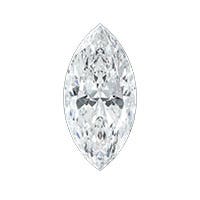Cut — The shape of a diamond refers to its physical appearance, while the cut refers to how well the diamond’s features interact with light.
Because marquise diamonds are a “fancy” cut, they are not graded. Even so, when buying a marquise diamond, make sure that it has a decent amount of sparkle; while marquise diamonds won’t look as fiery inside as round-shaped diamonds, they will outshine an emerald-shaped stone.
A poorly cut marquise diamond will show what’s known as a bow tie effect within the diamond--a shadow that takes away from the sparkle. The bow tie effect is visible to the naked eye, and their size varies from diamond to diamond.
Clarity — Each marquise-shaped diamond may have flaws. They are graded on clarity in the same way all diamonds are. The diamond clarity scale ranges from I (included) to F (flawless). You will most likely only see clarity grades as low as SI (slightly included). ship cohesive look unique ability prongs.
Marquise diamonds nearly always have an inclusion; however, a well-cut stone will hide any flaws from the eye with a brilliant sparkle.
Color —While marquise diamonds tend to show their color, this is often preferred; because marquise diamonds are a traditional stone dating back to the 1700s, a bit of color in the stone can look more authentic.
Carat — Marquise-shaped diamonds have very large crown surface areas, making them appear larger than their actual carat size. Use this advantage to either purchase a diamond that appears bigger than its carat or purchase a lower carat weight with the same appearance as a higher carat stone.
However, considering that a lab grown diamond can save you 20-30% on the price, many purchasers decide to use the leftover budget to add some to the wow factor and increase the carat size.
LEARN ABOUT THE 4 C'S
